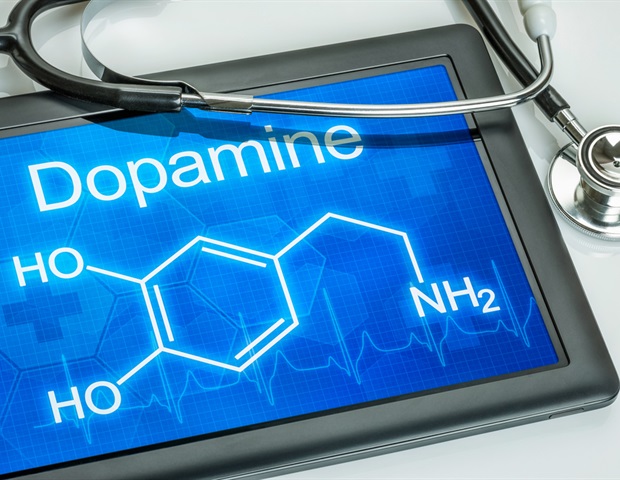
Dopamine, a chemical messenger within the mind, is generally identified for its position in how we expertise pleasure and reward. Nevertheless, new analysis from the Champalimaud Basis (CF) shifts the highlight in the direction of dopamine’s essential involvement in motion, with implications for our understanding and therapy of signs in Parkinson’s Illness (PD).
Think about the act of strolling. It is one thing most able-bodied folks do with out a second thought. But it’s really a posh course of involving varied neurological and physiological programs. PD is a situation the place the mind slowly loses particular cells, referred to as dopamine neurons, leading to diminished power and pace of actions. Nevertheless, there’s one other vital side that will get affected: the size of actions. Somebody with PD won’t solely transfer extra slowly but additionally take fewer steps in a strolling sequence or bout earlier than stopping. This examine reveals that dopamine alerts instantly have an effect on the size of motion sequences, taking us a step nearer to unlocking new therapeutic targets for enhancing motor operate in PD.
Dopamine is most carefully related to reward and pleasure, and is also known as the ‘feel-good’ neurotransmitter. However, for dopamine-deficient people with PD, it is sometimes the motion impairments that the majority impression their high quality of life. One side that has at all times us is the idea of lateralization. In PD, signs manifest asymmetrically, usually starting on one facet of the physique earlier than the opposite. With this examine, we wished to discover the idea that dopamine cells do extra than simply inspire us to maneuver, they particularly improve actions on the alternative facet of our physique”.
Marcelo Mendonça, examine’s first creator
Shedding gentle on the mind
To this finish, the researchers developed a novel behavioral process, which required freely-moving mice to make use of one paw at a time to press a lever with the intention to receive a reward (a drop of sugar water). To know what was occurring within the mind throughout this process, the researchers used one-photon imaging, just like giving the mice a tiny, wearable microscope. This microscope was aimed on the Substantia nigra pars compacta (SNc), a dopamine-rich area deep inside the mind that’s considerably impacted in PD, permitting the scientists to see the exercise of mind cells in real-time.
They genetically engineered these mice in order that their dopamine neurons would gentle up when energetic, utilizing a particular protein that glows below the microscope. This meant that each time a mouse was about to maneuver its paw or succeeded in getting a reward, the scientists might see which neurons have been lighting up and getting excited concerning the motion or the reward.
Observing these glowing neurons, the discoveries have been, fairly actually, illuminating. “There have been two forms of dopamine neurons blended collectively in the identical space of the mind”, notes Mendonça. “Some neurons turned energetic when the mouse was about to maneuver, whereas others lit up when the mouse obtained its reward. However what actually caught our consideration was how these neurons reacted relying on which paw the mouse used”.
How dopamine chooses sides
The crew seen that the neurons excited by motion lit up extra when the mouse used the paw reverse to the mind facet being noticed. For instance, in the event that they have been trying on the proper facet of the mind, the neurons have been extra energetic when the mouse used its left paw, and vice versa. Digging deeper, the scientists discovered that the exercise of those movement-related neurons not solely signaled the beginning of a motion but additionally appeared to encode, or characterize, the size of the motion sequences (the variety of lever presses).
Mendonça elaborates, “The extra the mouse was about to press the lever with the paw reverse the mind facet we have been observing, the extra energetic neurons turned. For instance, neurons on the correct facet of the mind turned extra excited when the mouse used its left paw to press the lever extra usually. However when the mouse pressed the lever extra with its proper paw, these neurons did not present the identical enhance in pleasure. In different phrases, these neurons care not nearly whether or not the mouse strikes, but additionally about how a lot they transfer, and on which facet of the physique”.
To check how dropping dopamine impacts motion, the researchers used a neurotoxin to selectively cut back dopamine-producing cells on one facet of a mouse’s mind. This methodology mimics situations like PD, the place dopamine ranges drop and motion turns into tough. By doing this, they might see how much less dopamine modifications the way in which mice press a lever with both paw. They found that decreasing dopamine on one facet led to fewer lever presses with the paw on the alternative facet, whereas the paw on the identical facet remained unaffected. This offered additional proof for the side-specific affect of dopamine on motion.
Implications and future instructions
Rui Costa, the examine’s senior creator, picks up the story, “Our findings recommend that movement-related dopamine neurons do extra than simply present basic motivation to maneuver – they will modulate the size of a sequence of actions in a contralateral limb, for instance. In distinction, the exercise of reward-related dopamine neurons is extra common, and does not favor one facet over the opposite. This reveals a extra complicated position of dopamine neurons in motion than beforehand thought”.
Costa displays, “The completely different signs noticed in PD sufferers may very well be maybe associated to which dopamine neurons are lost-; for example, these extra linked to motion or to reward. This might doubtlessly improve administration methods within the illness which are extra tailor-made to the kind of dopamine neurons which are misplaced, particularly now that we all know there are various kinds of genetically outlined dopamine neurons within the mind”.
Supply:
Journal reference:
Mendonça, M. D., et al. (2024). Dopamine neuron exercise encodes the size of upcoming contralateral motion sequences. Present Biology. doi.org/10.1016/j.cub.2024.01.067.


